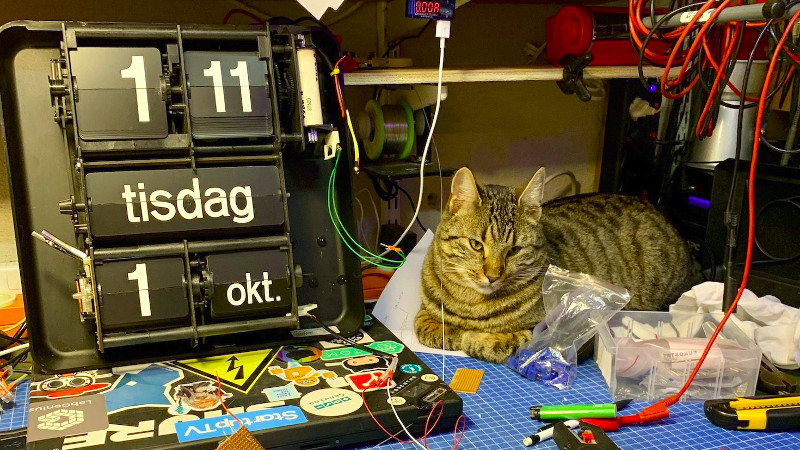There are multiple reasons why we like [iSax]’s rebuild of a Bodet flip clock from the early 1980s. First there’s the retro charm of the timepiece itself, then the electronics used to drive it, its electromechanical month length and leap year system, and finally because here is a maker lucky enough to have a beautiful tabby cat to share the workbench with.
For those of you unfamiliar with a flip clock, these devices have their digits as a series of hinged cards on a central rotor, with each one being exposed in turn as the rotor turns. This one is part of a distributed clock system in which the clients receive a 1 Hz pulse from a central time server to drive their motors, something easily replicated with an Arduino and an H-bridge. Particularly fascinating though is the month length mechanism, part of the calendar rotor system, it has a small DC motor that is engaged to advance the days automatically by whichever number as part of the month transition. Originally this was powered by a couple of AA batteries, which have now been replaced with a small DC to DC converter. You can see it in action in the video below the break.
With or without tabby cats, we see quite a few projects featuring them. If you can’t find one, you can always make your own.















Caption challenge for the cat –
You woke me for this ?
I’ m ready for my close up…..not that close !
Fig.-1, Cat is going, going… Fig.-2, Gone.
I remember I had a poetry class in January 1983. One of the poems was about one of these type of clocks and how it’d groan for a while before the next flap(s) flipped. “giving birth to a new era” Even at that time we were all nostalgic for these clocks. I think these must be from the late 70’s not the early 80’s
Flip digit clocks were state of the art through the 1980’s. If you wanted a large display easily visible in any lighting from a distance there wasn’t much competition for them. LED’s couldn’t really compete until the 2000’s, and large LCD’s only got common in the 1990’s and even then didn’t have the contrast of a good flip display with reflective paint. This was also true in other realms, such as industrial scoreboard displays which had to be visible in outdoor lighting both day and night.
My best friend had a talking LED alarm clock in 1983. I know this for a fact because we were both RAs that year and he’d leave his door open so it’d announce the start of boys only time in the dorms. The brand was Stratus or something similar and the first one we got from Skagg’s Drug in Yankton would talk nonsense such as “The time is 36 15 o’clock” He seriously considered keeping this one but replaced it with one that spoke the time accurately.
There was no novelty in the fact that it was LED, the novelty was only that it was a talking clock.
Actually the cat arranged to be there, to bring the work luck. And as it happens this a very interesting project. I’ve heard of the talking clocks. In fact the forerunner of Microchip during the late 1980s made a series of chips who did just that. Then added as an afterthought a chip to make it possible to do other things so they could talk back properly.